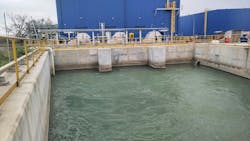5 ways to minimize business risks from wastewater
Every part of your industrial facility can contribute to business risks, and wastewater is no exception, especially as it is often an afterthought until the risks are already incurred.
By now, you’ve probably heard us talk about the many risks wastewater can pose. From financial and reputational to environmental, legal and even business continuity risks, poor management of wastewater can negatively impact almost every aspect of your business.
You want to avoid these risks, and we want to help you. Here are five things you can do today to minimize business risks from wastewater:
1. Understand your wastewater
Truly understanding what you are discharging can significantly minimize wastewater risks. This involves knowing your flow rates, total discharge volumes from different parts of production, the pollutants present and their concentrations, and any seasonal or market-driven variabilities affecting your discharges.
You can achieve this by implementing a consistent monitoring schedule and analyzing which processes in your production line generate wastewater to identify peaks and valleys. There are numerous inline monitors and sensors available to continuously collect data on your wastewater, helping you understand its composition, sources, and discharge patterns.
2. Understand your permits
Every industrial discharger requires a permit that sets discharge limits for volume and pollutants. Have you reviewed and understood these permits? Non-compliance with your permit can lead to significant, unnecessary risks, including fines, legal action and even denial of discharge to your utility, potentially resulting in production shutdowns or leading to very costly hauling alternatives.
To avoid these risks, review the discharge parameters allowed by your permit and compare them with your actual discharges. If you’re approaching or exceeding your limits, it may be time to employ onsite treatment technology to address those pollutants. Consider any future plans, as production expansions or product line changes will affect your discharges. Apply for new permits early and as often as necessary to avoid these risks.
3. Work with your utility
Your utility is not the bad guy; they are not out to get you. Building a good relationship with your utility can be beneficial for both parties. However, if you continuously discharge outside your limits, they may be forced to deny your wastewater or apply significant financial penalties, leaving you with fewer options for wastewater management. This can also impact your expansion plans; if the utility is nearing capacity, or has made infrastructure changes to their system that may be sensitive to pollution levels, your production expansions may be impacted, or you may be forced to find another wastewater management option.
Communicating with your utility on a frequent basis will help you plan for the future and learn about any upcoming surcharge increases that could affect your bill. They can help you understand your bills and provide resources to help lower them and alleviate strain on their facility.
4. Manage your wastewater holistically
Your wastewater is directly impacted by any upstream activities in your production facility. This includes production expansions, product line changes and changes in water usage to meet water efficiency goals. Though these changes may seem small, they can have significant impacts on your wastewater discharge, increasing your exposure to the discussed business risks.
Changes in water usage, in particular, have downstream effects. When you reduce water use upstream, you discharge less water, but your pollutant levels remain the same. The result is more concentrated wastewater. As water scarcity prevails and more companies implement lower water-use goals, being aware of this and managing your wastewater holistically will help you avoid associated risks.
5. Utilize onsite treatment
Utilizing an onsite treatment system can help ensure you remain within permit compliance, maintain a positive relationship with your utility, and manage your wastewater holistically. Often, discharging directly to the utility isn’t the best option, especially for industrial dischargers who generate complex, high-strength wastewater. This can lead to higher surcharges, greater non-compliance risks, and potential environmental and reputational risks.
An onsite system for pre-treatment can be the best way for your facility to avoid these risks. However, this requires implementing the right treatment technology. There are many options for onsite treatment, and now that you understand your wastewater and permit limits, you can choose the best one for your specific needs. Choose a technology that will reduce your business risks, not create new ones.
Aquacycl
